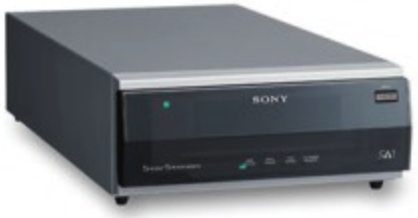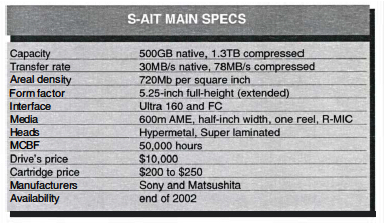History 2001: Sony and MKE Promises Half-Terabyte Tape Drive By End of 2002
Based on S-AIT
By Jean Jacques Maleval | April 10, 2023 at 2:01 pmWe had an early taste of the news and were even lucky enough to see this extraordinary machine, Sony’s S-AIT, at the last CeBIT.

Of course, it was only a nonfunctional prototype, but the tape routing was operational, and the helical head spun. At the time, Sony’s people mentioned some extremely impressive specs: one terabyte native capacity with a 60MB/s transfer rate.
Since then, unfortunately, the company has revised its claims, dividing those figures in two. Even 500/30 is nothing to sneeze at, however, and the product is still promised for the end of 2002.
Its price should land somewhere around $10,000 for the drive, $200-$250 for the cartridge.
No other tape company has a roadmap that will allow it to attain such specs next year. LTO may hit 200/30, with Quantum’s SDLT at 160/16 and Exabyte’s M3 at 120/18.
All, with the exception of Sony, will fall under the HDD mark, where the highest capacities should easily exceed 300GB by the end of 2002.
The only other product that comes close will be Tandberg’s aMaSS, at 600/64, not expected before 4Q03.
In terms of technology, Sony uses its AIT helical scan base, adapted not to a small 8mm cartridge with two axes, but to a cartridge with a single axis housing 600m of half-inch tape (compared to 203m and 8mm for AIT-3), in a cartridge similar to LTO.
AIT-3 and S-AIT share the same areal density: 720Mb per square inch. Both are equipped with the same R-MIC, a flash memory that keeps tabs on cartridge data and the files written to tape, to accelerate access.
Of course, the two products will be incompatible. The AIT drive conformed to a 3.5- inch form factor, while S-AIT will be housed in an extended 5.25-inch full-height volume, which is 30cm long or a few more centimeters longer than DLT or LTO drives, according to Tadashi Ozue, Sony’s chief research scientist.
“This is not an issue for library vendors since they have time to design in the drive and have enough space,” noted Mark Lufkin, Sony’s GM of storage solutions marketing.
The device will incorporate an automatic head cleaning system and “an effective leader block tape threading system with a simplified tape load path.”
As for the new technology’s roadmap, it should roughly adhere to that of AIT. This means an S-AIT-2 will follow, at 1,000/40, based on AIT-4 recording technology which is supposed to be 100/24 in 2003.
Sony is eager to point out “the potential to scale up to 4TB of uncompressed capacity in a single cartridge” with the use of MR and GMR heads.
We were not the only ones who were impressed by Sony’s project. A second manufacturing source agreement has already been concluded. Beginning in 2003, 2 subsidiaries of the Matsushita group, MKE and MEI, will respectively make the drive and the media, compared to current AIT drives, which are produced solely by Sony.
As Lufkin puts it: “We learnt the hard way about the need for multiple sources.”
Three library manufacturers, Adic, Qualstar and Spectra Logic are the first to express their intention to integrate the S-AIT into their automation products.
This announcement also reignites the old debate between longitudinal (DLT, LTO) and helical scan (AIT, Mammoth) technologies.
More importantly, it raises questions about Sony’s strategy vis-a-vis computer tape drives. AIT will no doubt maintain its current course, based on its smaller form-factor and its superior access times, even if the size of the cartridge limits capacity. S-AIT, however, will clearly take on the costly DTF, currently at 200/24 in its DTF-2 version, and only (!) anticipated at 400/48 in its next gen.

This article is an abstract of news published on issue 166 on November 2001 from the former paper version of Computer Data Storage Newsletter.













 Subscribe to our free daily newsletter
Subscribe to our free daily newsletter
